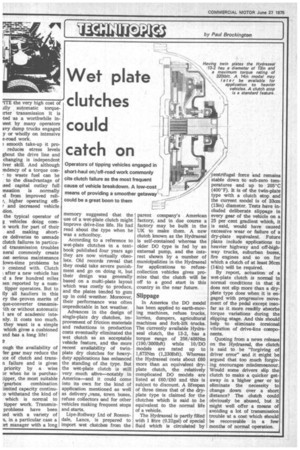Wet plate clutches could catch on
Page 46

If you've noticed an error in this article please click here to report it so we can fix it.
Operators of tipping vehicles engaged in short-haul on/off-road work commonly cite clutch failure as the most frequent cause of vehicle breakdown. A low-cost means of providing a smoother getaway(-7_ could be a great boon to them memory suggested that the use of a wet-plate clutch might improve drive-line life. He had read about the type when he was a schoolboy.
According to a reference to wet-plate clutches in a textbook published four years ago they are now virtually obsolete. Old records reveal that they could take severe punishment and go on doing it, but their design was generally based on a multi-plate layout which was costly to produce, and the plates tended to gum up in cold weather. Moreover, their performance was often unpredictable in hot weather.
Advances in the design of single-plate dry clutches, improvement of friction materials and reductions in production costs eventually eliminated the wet clutch as an acceptable vehicle feature, and the more recent availability of twinplate dry clutches for heavyduty applications has enhanced the standing of the type. But the wet-plate clutch is still very much alive—notably in America—and it could come into its own for the kind of application mentioned as well as delivery brans, town buses, refuse collectors and for other vehicles making frequent stops and starts.
Lipe-Rollway Ltd of Rossendale, Lanes, is prepared to import wet clutches from the parent company's American factory, and in due course a factory may be built in the UK to make them. A new clutch known as the Hydraseal is self-contained whereas the older DO type is fed by an external pump, and the interest shown by a number of municipalities in the Hydraseal for applications to refusecollection vehicles gives promise that the clutch will be off to a good start in this country in the near future.
Slippage
In America the DO model has been applied to earth-moving machines, refuse. trucks, lorries, dumpers, agricultural machines and fork-lift trucks. The currently available Hydraseal clutch, the 13-2, has a torque range of 258/408Nm (190/3001bft) while 10/DO models are rated up to 1,673Nm (1,230Ibtt). Whereas the Hydraseal costs about £60 more than an equivalent dryplate clutch, the relatively complicated DO models are listed at £60/£80 and this is subject to discount. A lifespan of three times that of the dryplate type is claimed for the clutches which is said to be equivalent to the normal life of a vehicle.
The Hydraseal is partly filled with 1 litre (0.22gal) of special fluid which is circulated by .centrifugal force and remains stable down to sub-zero temperatures and up to 205°C (400'F). It is of the twin-plate type with a clutch stop and the 'current model is of 33an (13in) diameter. Tests have included deliberate slippage in every gear of the vehicle on a 25 per cent gradient which, it is said, would have caused excessive wear or failure of a dry-plate equivalent. Future plans include applications to heavier highway and off-highway trucks, suburban buses, fire engines and so on for which a clutch of at least 36cm (14in) will be required.
By report, actuation of a wet-plate clutch is normal in normal 'conditions in that it does not .slip more than a dryplate type does when it is engaged with progressive movement of the pedal except insofar as it more readily absorbs torque variations during the slipping stage. And this should help to eliminate torsional vibration of drive-line components.
Quoting from a news release on the Hydraseal, the clutch is said to be "forgiving of driver error" and it might be argued that too much forgiving encourages misdemeanour. Would some drivers slip the clutch to make a quicker getaway in a 'higher gear or to eliminate the necessity to change down over a short distance? The clutch could obviously be abused, but it might well offer a means of avoiding a lot of transmission trouble at a cost which should be recoverable in a few months of normal operation.




















































































